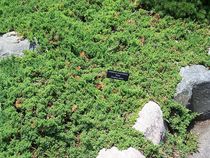
Picture of the has been licensed under a GFDL
Original source: Own work
Author: SEWilco
Permission: GNU Free Documentation License
Original source: Own work
Author: SEWilco
Permission: GNU Free Documentation License

Picture of the has been licensed under a Creative Commons Attribution.
Permission: Some rights reserved
Permission: Some rights reserved
Juniperus procumbens
It is a prostrate plant, which usually grows between 20-30 cm tall, although sometimes as high as 50 cm; while it does not get very tall it can get quite wide, 2-4 m across or more, with long prostrate branches. The branches tend to intertwine and form a dense mat. The leaves are arranged in decussate whorls of three; all the leaves are juvenile form, needle-like, 6-8 mm long and 1-1.5 mm broad, with two white stomatal bands on the inner face. It is dioecious with separate male and female plants. The cones are berry-like, globose, 8-9 mm in diameter, dark blackish-brown with a pale blue-white waxy bloom, and contain two or three seeds ; they are mature in about 18 months. The male cones are 3-4 mm long, and shed their pollen in early spring. It is dioecious, producing cones of only one sex on each plant.Juniperus procumbens is a low-growing shrubby juniper native to the southern Japan. Its status as a wild plant is disputed; some authorities treat it as endemic on high mountains on Ky?sh? and a few other islands off southern Japan, while others consider it native to the coasts of southern Japan (north to Chiba Prefecture) and also the southern and western coasts of Korea. It is closely related to Juniperus chinensis, and is sometimes treated as a variety of it, as J. More
Juniperus procumbens is planted in the highlighted USDA hardiness zones to the left and is not known to widely escape cultivaton. More
